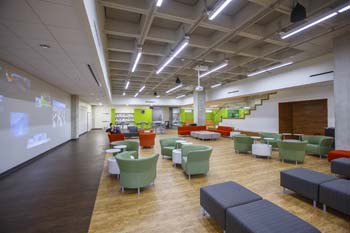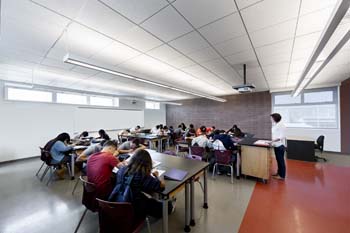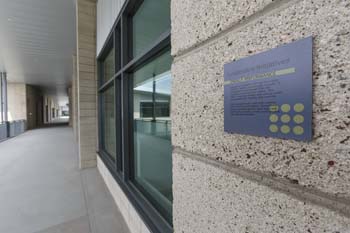Five Trends in K-12 School Design Everyone Should Consider
By Guest Blogger Kimberley Coffeen, CEFPI, LEED AP BD+CWe are living through a time where many industries and fields are facing a dramatic shift. Educational programming and K-12 school design are certainly no exceptions. While there are many ways to address the needs of today’s learning environments, not all need to be grandiose. Instead, we can focus on small moves that will have the greatest change, like buying new furniture, improving connectivity and developing a technology plan that supports long-term training and upkeep. Today, we dive into five trends in K-12 school design and their impacts to education:
From career technical education to project-based learning and the School of One concept, educators are constantly reviewing methods to make learning relevant and personalized for every student. Small learning communities (SLCs) can achieve this by refocusing the attention away from grade level groupings and on focus of teamwork and a community of learners around a specific area of study.
At Fremont High School in Los Angeles, Calif., administrators prioritized SLCs as the driving concept behind the reimaging of their school. The district’s vision was anchored in a renovation of the existing three-story classroom building and the construction of a new two-story student union building, which is home to a new library, kitchen, and dining hall. For students, the SLCs promote a sense of identity; the new indoor-outdoor cafeteria encourages school spirit and together with the library provides an exciting place for students to collaborate before, during and after school. The resulting design won a Leroy F. Greene Design and Planning Award of Honor at the 2014 CASH/AIACC conference for the successful reorganization of the school’s core educational programs to promote community and collaboration.
2. Distance Learning
Distance education, an option for students to take learning outside of traditional learning spaces, is transforming classroom requirements. In fact, distance learning could have a drastic impact on physical schools. Some are saying the impact may be as high as 50% fewer high school students attending traditional “brick and mortar” schools in the future.
Just 10 years ago we designed classroom spaces to have hard wire everything and a permanent bank of computers along one side of the classroom. This is now changing. Over the last few years, mobile devices and tablets are driving a dramatic shift in accessibility. This impacts how we envision the classroom setting, and it does begin to challenge the sizes of high schools with regard to usable capacity when the potential in the future may be that many of the students will be off-school, on-line and working in the community.
_s__t8a2198_lpa_model.jpg) 3. Flexible Learning Environments
3. Flexible Learning Environments
Furniture and equipment specifications are central to the success of a school’s educational program, and detail should not be overlooked. Just as the solutions must evolve with the program, it is imperative to implement sustainable design strategies, such as overhead access to utilities and flexible connections to the outdoors. In fact, research has shown that flexible learning environments can have positive impacts on the way that interactions and learning are accomplished.
The classroom does not have to be square, or maybe should not be. Planning for diverse types of spaces of different sizes, purposes, and qualities can enhance the classroom settings. Designs today encourage the opportunity for collaboration by having a layout that promotes easy flow into adjacent spaces. Just the ability to rearrange a room in an instant is huge in reinforcing the lecture is just one part of delivering content. This may change how districts traditionally purchase furniture for schools; by considering a five to 10 year furniture refresh instead.
It is clear that a well-designed classroom that includes proper ventilation, good acoustics, quality indoor air quality (IAQ) and abundant daylight has a positive impact on students’ attendance, concentration and performance. Acknowledging that good design supports the activities and comfort of the occupants, our sustainable design approach is measured through the Collaborative for High Performance Schools (CHPS) and Leadership in Energy and Environmental Design (LEED).
At e3 Civic High, learning not only takes place within the facilities, but also about the facilities. As students walk on campus, each sustainable strategy applied to the school’s design is described to them with signage and interactive displays throughout the campus. The school is designed to and currently tracking LEED Gold certification through the U.S. Green Building Council. Students will have the opportunity to learn what this means, not only for them, but for their home and the environment.
5. Incorporating Technology
Agility is important to any 21st century educational environment, specifically with SLCs. The spaces need to remain relevant to the changing technologies and programs used in the industry.
We know that flexible furniture can change the physical layout of a classroom for programming needs. Similarly, flexible furniture can impact a student’s interaction with technology—a must for any 21st century learning environment. Some furniture solutions include tables with “plug and play” power and data ports, which allows the space to serve as either a technologically-rich, one-to-one computing environment, or as a general classroom.
These five trends will change and evolve along with the education system; however, the need for participation does not. Remember that no matter what moves you make in a student’s learning environment, a fundamental step is to be a part of the conversation. Even if you are simply listening in on the conversation, your participation is crucial in identifying which next steps are best for you.
Kimberly Coffeen is a Senior Educational Facility Planner at LPA Inc. She is a Registered California Architect, active member of CEFPI, and Chair of the Collaborative for High Performance Schools (CHPS) Green Product Database. In 2009, she co-authored "Green School Primer: Lessons in Sustainability."
_1428.jpg)
_s__u0a4929.jpg)
